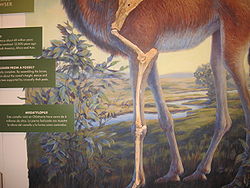- Megatylopus
-
Megatylopus
Temporal range: MioceneLeg bone of Megatylopus Conservation status FossilScientific classification Kingdom: Animalia Phylum: Chordata Class: Mammalia Order: Artiodactyla Suborder: Tylopoda Family: Camelidae Genus: Megatylopus
Matthew & Cook, 1909species - M. gigas (type)
- M. cochrani
- M. matthewi
- M. primaevus
Megatylopus is an extinct and large genus of terrestrial herbivore the family Camelidae, endemic to North America from the Miocene through Late Pliocene—Early Pleistocene boundary 13.6—1.8 mya, existing for approximately 11.8 million years.[1]
Contents
Taxonomy
Megatylopus was named by Matthew and Cook (1909). Its type is Megatylopus gigas. It was synonymized subjectively with Paracamelus by Macdonald (1959). It was assigned to Camelidae by Matthew and Cook (1909), Webb (1965), Patton (1969), Harrison (1985), Carroll (1988) and Honey et al. (1998).[2][3][4][5][6]
Morphology
It stood about 4,20 m (14 ft) tall, with its legs already measuring 2,10 m (7 ft). Fossil remains have been found in Oklahoma, USA.
Body mass
A single specimen was examined for estimated body mass by M. Mendoza, C. M. Janis, and P. Palmqvist. This specimen was estimated to weigh 1,698.4 kg (3,700 lb) [7]
Fossil distribution
Fossil distribution ranged from North Carolina to California.
References
- ^ PaleoBiology Database: Megatylopus, basic info
- ^ J. R. Macdonald. 1959. Journal of Paleontology 33(5)
- ^ S. D. Webb. 1965. Bulletin of the Los Angeles County Museum of Natural History, Science 1
- ^ T. H. Patton. 1969. Bulletin of the Florida State Museum 14(2)
- ^ R. L. Carroll. 1988. Vertebrate Paleontology and Evolution. W. H. Freeman and Company, New York 1-698
- ^ J. G. Honey, J. A. Harrison, D. R. Prothero and M. S. Stevens. 1998. Camelidae. In C. M. Janis, K. M. Scott, and L. L. Jacobs (eds.), Evolution of Tertiary Mammals of North America 1:439-462
- ^ M. Mendoza, C. M. Janis, and P. Palmqvist. 2006. Estimating the body mass of extinct ungulates: a study on the use of multiple regression. Journal of Zoology 270(1):90-101
External links

This prehistoric even-toed ungulate-related article is a stub. You can help Wikipedia by expanding it. This prehistoric mammal-related article is a stub. You can help Wikipedia by expanding it.


